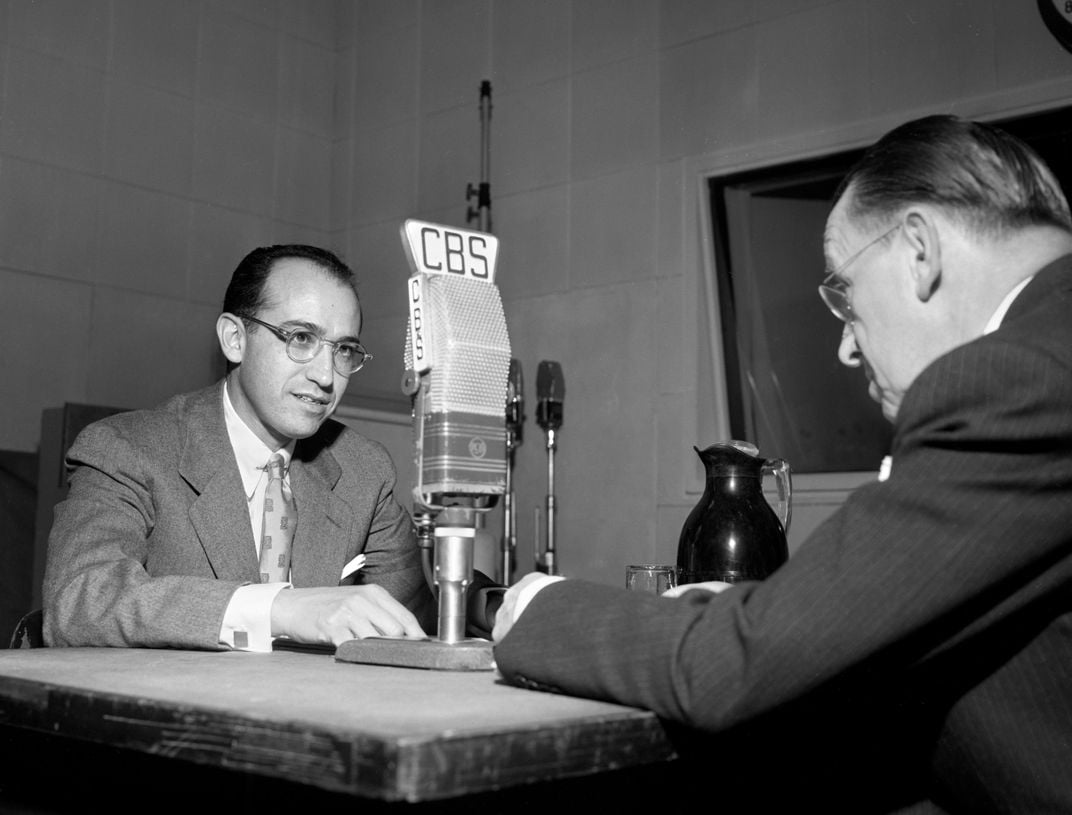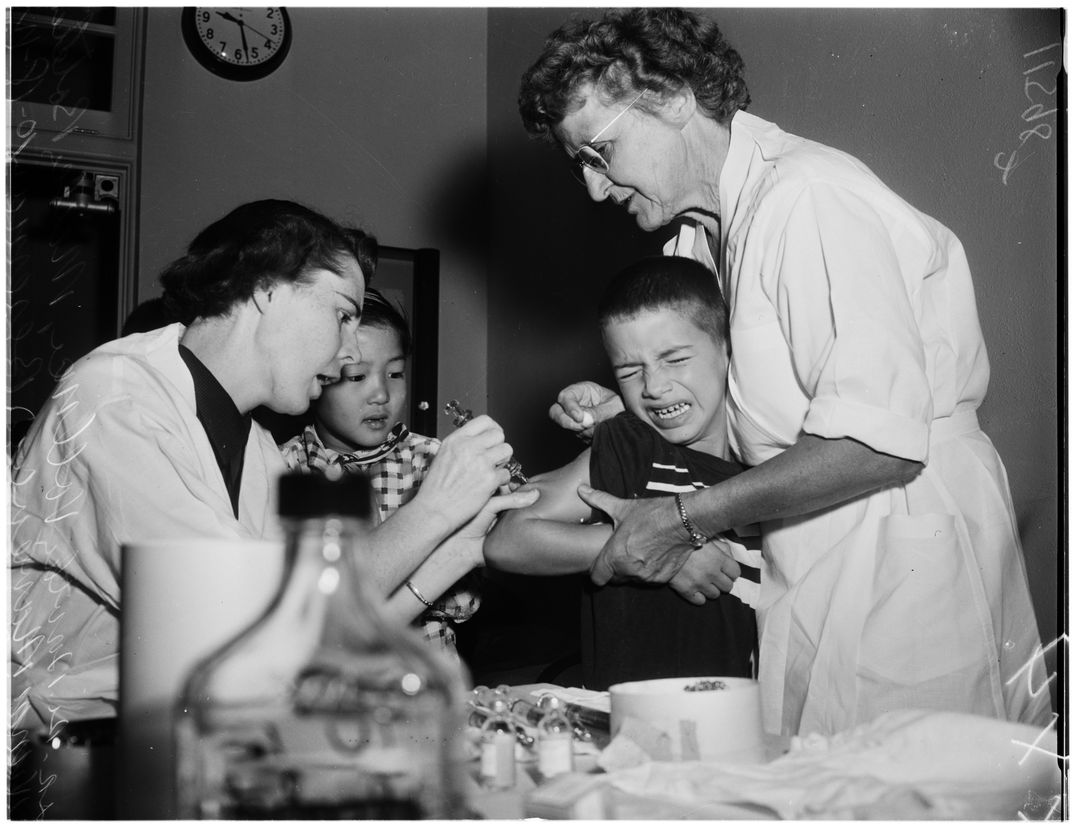The Press Made the Polio Vaccine Trials Into a Public Spectacle
As a medical breakthrough unfolded in the early 1950s, newspapers filled pages with debates over vaccine science and anecdotes about kids receiving shots
:focal(807x632:808x633)/https://tf-cmsv2-smithsonianmag-media.s3.amazonaws.com/filer/db/58/db5878d2-be06-48bd-ab00-ab710ff491c3/polio2.png)
The initial announcement came over the radio one Thursday in March: at last, scientists had developed a vaccine. For decades, communities around the United States had been struck by recurring waves of infectious, debilitating and sometimes deadly virus. The previous year had been a particularly bad one; epidemic. Almost 60,000 new cases and more than 3,000 fatalities had been reported, the vast majority of them in young children.
But the campaign for a cure was finally beginning to produce promising developments. And in 1953, the physician Jonas Salk told a national radio audience for the first time that a vaccine had proved successful in preliminary tests. "These studies provide justification for optimism, and it does appear that the approach in these investigations may lead to the desired objective,” Salk said. “But this has not yet been accomplished.”.
Maybe, he explained, after more extensive trials, it would effectively inoculate young people against the threat of polio.
Maybe.
From the beginning, Salk, a medical researcher based in PIttsburgh, worried about expectations. The New York Times later reported that he hadn’t wanted to make the radio announcement at all. “If Dr. Salk had his way,” the article reflected, “no word of discovery would have been published until the vaccine had been tested thoroughly.” But the news of a vaccine had already gradually begun seeping out from the National Foundation for Infantile Paralysis events where Salk had spoken earlier in the year about his initial successes. “When the news came out in the spring of 1953,” the Times article explained, “he rushed to New York to see that the press did not overstate the matter.”
The morning papers reflected Salk’s caution. In reporting carried around the country, Associated Press journalists pronounced the vaccine safe and promising, but emphasized that questions remained unanswered. Many papers led with the revelation that shots wouldn’t be available by the summer, when polio always wreaked the most havoc. In many others, the announcement didn’t even make the front page; in Wilmington, Delaware’s News Journal, it was relegated to page 40, behind pieces on the state’s annual Mother of the Year award and subway fare hikes in New York City.

Salk had succeeded in controlling the media narrative about his findings—at least for a day. But in doing so he had also thrust himself and his vaccine into the bright light of national scrutiny, and there would be no going back. To the long-suffering public, he became a specific receptacle for hope. To the scientific community, already widely doubtful of his chosen method for preparing his vaccine, he became a target for criticism and rivalry, even as he also garnered support. And to the press, he became the main character in the story of the search for a cure.
In the months following his announcement, that publicity mainly served to stoke anticipation and turn Salk into a minor celebrity. The real spectacle began a year later, when Salk’s vaccine moved out of his Pittsburgh laboratory and into the more extensive testing he had mentioned—a series of trials that would become the most significant public health experiment in the history of the United States. Over the course of less than 12 months, 1.8 million children in 44 states—and in Canada and Finland—would step up to participate in the vaccine trials. It was an unprecedented scale, never matched in the country before or since. By comparison, Pfizer and BioNTech’s COVID-19 vaccine trials ended ten months after the vaccine was first developed and involved roughly 43,500 test subjects; Moderna’s, completed in the same time period, included just over 28,200.
Also unprecedented was the methodology for many of the trials: They were the first to employ the double-blind method, in which children were randomly assigned to receive either placebos or a series of three real shots, so that the effects of the vaccine could be observed in comparison with a control.
It was, in sum, a massive, complicated, historic effort to advance medical science. And all of it—the trials themselves, as well as the doubts, debates, and hopes bound up in them—unfolded in public, with the scrutiny of the scientific community, the press, and the American people on full display.
The main tenor of the trial coverage was one of uncertainty. The papers pondered many of the same questions that have become familiar in the current vaccine rollout: When would shots be available? What kind of vaccine, Salk’s or competing models that took a different approach, would be more effective? What could all of it mean for the future of the disease, and the communities it had haunted for so long? But the open-ended nature of the public trials raised even more fundamental questions. Chief among them: Would the vaccine really work at all?
/https://tf-cmsv2-smithsonianmag-media.s3.amazonaws.com/filer/84/fb/84fb3cec-4a94-4ea8-ba28-2f162b2263e5/gettyimages-515280726.jpg)
Through the lens of hindsight, the coverage during that time period was, if anything, understated. Alongside accurate information, the uncertainty opened up space for fears that proved unwarranted and estimates that ultimately fell far short of the truth. Newspapers correctly reported that the vaccine wouldn’t be available to the public for one to three years after Salk’s announcement. But they also warned that the vaccine, as earlier attempts at inoculation had decades earlier, might cause inflammation of the brain or otherwise afflict recipients with polio symptoms (it didn’t).
A major source of concern in the coverage was Salk’s decision to use inactivated polio in his vaccines, rather than live, but weakened, strains of the virus. Medical orthodoxy, informed by the success of the smallpox vaccine, held that a killed-virus vaccine like Salk’s wouldn’t effectively protect recipients against infection. This debate had simmered behind closed doors in the scientific community before Salk’s announcement, but as the vaccine trials unfolded it broke out into the open and generated waves of headlines—even though the concerns had little to no real substantiation. Dr. Alfred Sabin, who was in the process of developing his own vaccine using live virus strains, argued that Salk’s could potentially cause more cases of polio than it would prevent, and that all manufacture and testing should be stopped (Salk’s methodology actually has proven less likely to infect patients with polio than Sabin’s, if also slightly less effective in boosting community immunity).
In August 1953 another doctor expressed fear that Salk’s vaccine would “protect children for a few years and then ... leave them in great danger of getting a severe type of polio” (no such crisis manifested and, by all accounts, the vaccine grants long-lasting immunity). And a year later, a radio broadcaster warned his audience in that the vaccine “may be a killer” because, he said, public health services had found that in 70 percent of the batches they tested the virus hadn’t been inactivated at all (officials and Salk himself quickly stepped up to counter that report).
More than any of those doubts or warnings, though, the press was full of reminders that the trials weren’t over yet, that the future was unknown, that more work was to be done. “Until these obstacles are overcome,” a New York Times reporter summarized three days after Salk had made his initial announcement, “it cannot be reported that a surefire vaccine against polio has been developed. But we are on the way.”
Some of the strongest champions of Salk’s vaccine continued to push for that measured outlook up until the very end of the trials. Less than two weeks before their conclusion, a group of institutional backers—comprising The National Foundation for Infantile Paralysis and six pharmaceutical manufacturers—publicly classified their support as a “calculated risk.” “We have not had either official or unofficial assurances that the vaccine is successful,” one pharmaceutical executive stressed.

Even under the weight of all those unknowns, however, hundreds of thousands of children—and their parents—continued to participate in the vaccine testing. Their stories became a constant in the coverage alongside all the warnings, the debates, the reports of other children who had already taken part later contracting polio. Newspapers regularly reported on new masses of volunteers and filled columns with quotes and anecdotes from elementary school students who had overcome their own personal fears of the needle, often encouraged by the promise of candy.
Randy Kerr, a 6-year-old from Virginia who received the inaugural shot in the national trials, earned particular celebrity among this group. Papers all around America carried his photo and reported that he’d been concerned his poison ivy would prevent him from participating after “begging all week to be the first,” as his teacher recalled.
“It didn’t hurt,” Randy told reporters. “I could hardly feel it. It doesn’t hurt as much as a penicillin shot.”
Parents, who signed volunteer waivers for their children and helped organize trials and fund-raising campaigns, were cast in a more muted role in the press. But when featured, they were more articulate about the significance of the trials and often offered up quiet hope amid the doubt. “As parents we are grateful to hear that this vaccine is to be tested,” one Utah PTA president summarized to reporters, “because, if successful, it might well mean that the day is nearing when our children really can be protected.”
Article after article also cited experts who insisted that the vaccine was “safe,” “perfectly safe,” safe “beyond all doubt.” These served as a counterbalance to every fear-sparking claim; an underlying reassurance that the testing could keep moving forward, and that there could be a happy resolution at the end of it all.
Then, in April 1955, that happy resolution arrived.Headlines broke through months of practiced restraint to proclaim researchers’ final report findings without caveat: “Polio Vaccine Both Safe, Effective”; “Salk Vaccine Can Conquer Polio;” “End of Polio In Sight.”
The logistics of administering millions upon millions of vaccines still had to be worked out. In the meantime, more children would be afflicted with polio, with more instances of infantile paralysis, more deaths. Forty thousand of those infections would be brought on—infamously—by a manufacturing error in the vaccine itself, an event which spurred another period of doubt and reassurance in the press.It would be 24 years before polio was eradicated in the United States, with Sabin’s easier-to-administer oral vaccine taking the starring role for most of that time.
But after years of very public uncertainty, the press and the public had a clear answer and a clear endpoint: Polio could be eliminated. Church bells rang out around the country. Hope, at last unrestrained by not yets, lit the flame for a massive, vaccination effort like nothing the country had ever seen. And in the end, the celebratory headlines of April 1955 weren’t an overstatement at all.